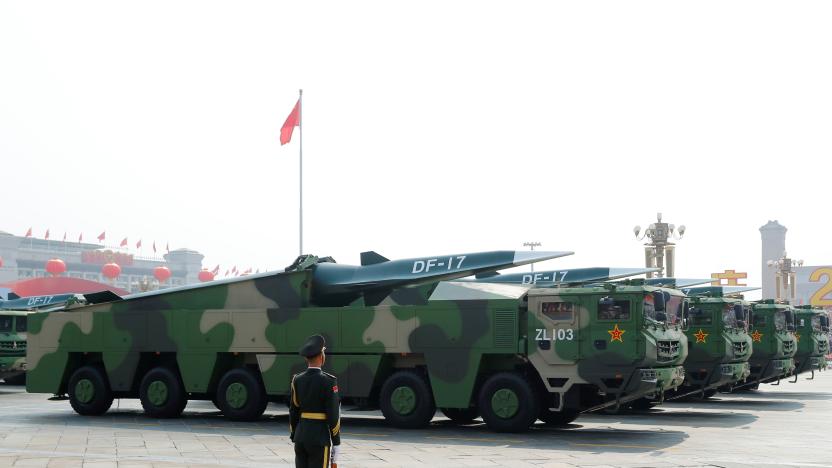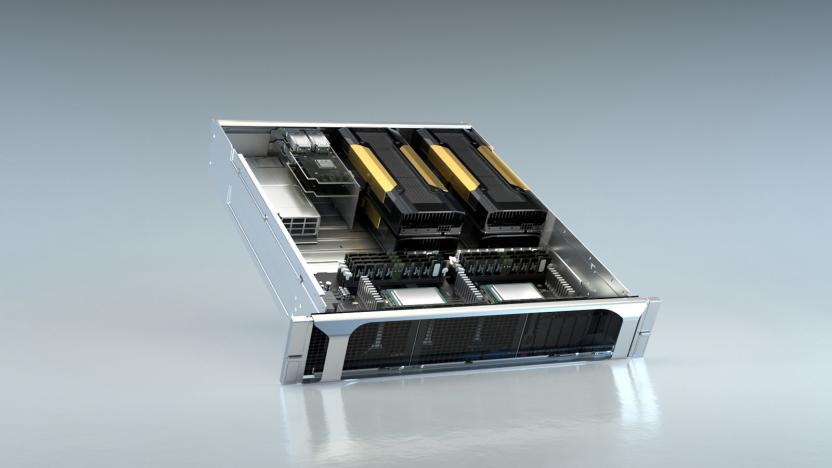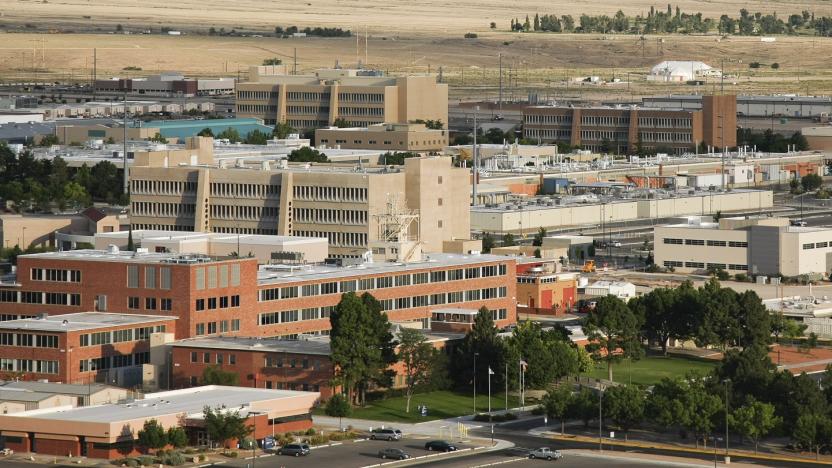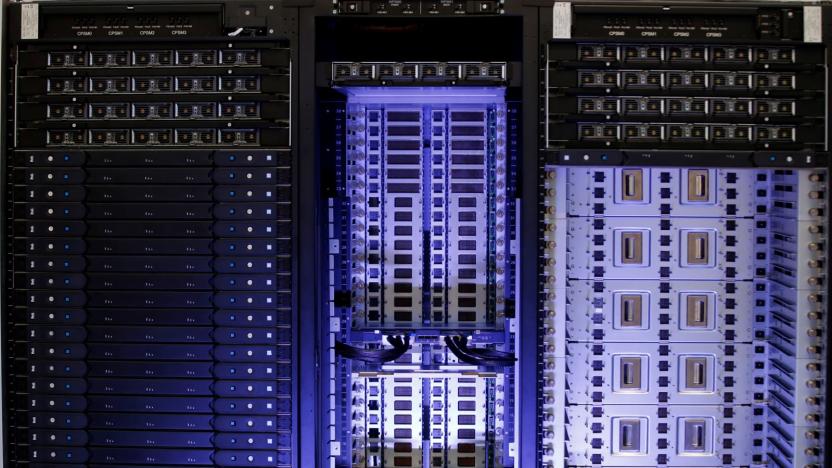supercomputers
Latest

NVIDIA's next generation of AI supercomputer chips is here
NVIDIA has launched its next-generation of AI supercomputer chips that will likely play a large role in future breakthroughs in deep learning and large language models.

Hitting the Books: Why AI won't be taking our cosmology jobs
In "The Universe in a Box" cosmologist Andrew Pontzen discusses how recent advances in supercomputing technology are revolutionizing our capability to model the complexities of the cosmos on a smaller scale.

US set to impose more trade restrictions on Chinese AI and supercomputer companies
The White House is set to unveil rules that would further restrict access to advanced computing technology in China that could be used by its military.

NVIDIA's EGX supercomputer tech can crunch 1.6 terabytes a second
Much like Microsoft, NVIDIA is shifting big parts of its tech toward the enterprise space to rely less and less on the messy and competitive world of consumer graphics. To that end, it has unveiled the NVIDIA EGX Edge Supercomputing Platform that marries NVIDIA's CUDA-X software with certified GPU servers. The tech is supported by Microsoft on its Azure and Azure AI apps, and has been adopted by companies like Walmart, Samsung and BMW, as well as the cities of Las Vegas and San Francisco, NVIDIA said in a press release.

World's largest ARM supercomputer is headed to a nuclear security lab
Most supercomputers are focused on pure processing speed. Take the DOE's new Summit system, which is now the world's most powerful supercomputer, with 9,000 22-core IBM Power9 processors and over 27,000 NVIDIA Tesla V100 GPUs. But processing performance isn't everything. Last year, Hewlett Packard Enterprise announced The Machine, its prototype for a supercomputer built around blazing fast memory. It's meant to churn through tons of data, though it can handle it's fair share of high performance computing (HPC) jobs.

Europe enters race to build world-class supercomputers
Supercomputers are a crucial research tool for medicine, aviation, robots and weapons, but there are only three dominant players: The US, Japan and China. Europe has had enough of that situation, however, and announced plans to spend up to $1.2 billion to develop its own technology. The aim is to develop its own exascale machines (that can do a billion billion calculations per second) by 2022-23. "It is a tough race and today the EU is lagging behind," said EC comissioner Andrus Ansip.

Watch the highlights of NVIDIA's GPU Technology Conference keynote
Under NVIDIA founder Jensen Huang's iconic leather jacket is one of the tech industry's sharpest CEOs -- a man who can not only talk eloquently about GPU architecture, machine learning and the limits of Moore's Law, but do so for hours without a strict script. It's an impressive feat, but if you're not well versed in the technology of server GPUs, his talks can be a little hard to digest. That's why we cut Huang's two hour GTC keynote into an easily digestible clipshow.

NVIDIA's first Volta-powered GPU sits in a $149k supercomputer
If you've been waiting for NVIDIA to finally take the lid off of Volta, the next generation of its GPU technology, your day has finally come. Today at its GPU Technology Conference, the company announced the NVIDIA Tesla V100 data center GPU, the first processor to use its seventh-generation architecture. Like the Tesla P100 the processor it's replacing, the Volta-powered GPU is designed specifically to power artificial intelligence and deep learning so, naturally, it's flush with power. Built on a 12nm process, the V100 boasts 5,120 CUDA Cores, 16GB of HBM2 memory, an updated NVLink 2.0 interface and is capable of a staggering 15 teraflops of computational power. It's also the GPU that drives the company's updated DGX-1 supercomputer, too.

IBM's big bet on Watson is paying off with more apps and DNA analysis
IBM's cognitive computer Watson is on a roll. After spinning it out as a $1 billion division last year, IBM went on to give Watson a flashy new home in Manhattan, made it a more tool for doctors with Watson Health Cloud, and it even proved its culinary chops with a new cookbook. Today IBM showed off several more examples of the supercomputer's growing ecosystem, including new Watson-powered apps that can do things like find you the ideal therapist, or help hotel staff better help guests. It's also partnered with more than a dozen cancer institutes who will use Watson to analyze DNA and offer personalized treatment profiles for patients. It may have started out somewhat gimmicky as a Jeopardy contestant, but IBM is also steadily showing how Watson could also be a truly useful tool for all of us.

DARPA taps golden age computers to solve tough simulations
If you thought modern computers were fast enough to solve any problem, nope! While certainly powerful, modern supercomputers aren't always great at complex fluid and plasma dynamic simulations, and DARPA, the outfit that does science for the US defense department, wants to fix that. To do so, it's invoking to the age of analog computers, "which solve equations by manipulating continuously changing values instead of discrete measurements." As an example, it cited the Norden bombsight, which calculated bomb trajectories using analog methods. That said, it's not planning on going back to vacuum tubes and rotating capacitors.

IBM manufactures light-based 'nanophotonic' chips to let the terabytes flow
IBM's taken a large step toward computer chips that use photons instead of electrons by manufacturing the first 90nm silicon-based optical processing modules. It did so using the CMOS nanophotonics technology we first saw back in 2010, creating tranceivers capable of 25Gbps transfer speeds. By multiplexing a large number of those streams to a single fibre, "terrabytes of data" per second could flow between distant computer systems," according to IBM. The 90 nanometer light circuits should allow data-hungry servers or supercomputers to scale up rapidly in speed "for the next decade, and at the desired low cost," according to the researchers. It's now primed for commercial development, meaning we could see an end to bottlenecks in systems "a few centimeters or a few kilometers" apart from each other. Check the PR for the detailed technical skinny.

Insert Coin: The Parallella project dreams of $99 supercomputers
In Insert Coin, we look at an exciting new tech project that requires funding before it can hit production. If you'd like to pitch a project, please send us a tip with "Insert Coin" as the subject line. Parallel computing is normally reserved for supercomputers way out of the reach of average users -- at least at the moment, anyway. Adapteva wants to challenge that with its Parallella project, designed to bring mouth-watering power to a board similar in size to the Raspberry Pi for as little as $99. It hopes to deliver up to 45GHz (in total) using its Epiphany multicore accelerators, that crucially, only chug 5 watts of juice under normal conditions. These goliath speeds currently mean high costs, which is why they need your funds to move out of the prototype stage and start cheap mass production. Specs for the board are as follows: a dual-core ARM A9 CPU running Ubuntu OS as standard, 1GB RAM, a microSD slot, two USB 2.0 ports, HDMI, Ethernet and a 16- or 64-core accelerator, with each core housing a 1GHz RISC processor, all linked "within a single shared memory architecture." An overriding theme of the Parallella project is the openness of the platform. When finalized, the full board design will be released, and each one will ship with free, open-source development tools and runtime libraries. In addition, full architecture and SDK documentation will be published online if-and-when the Kickstarter project reaches its funding goal of $750,000. That's pretty ambitious, but we're reminded of another crowd-funded venture which completely destroyed an even larger target. However, that sum will only be enough for Adapteva to produce the 16-core board, which reportedly hits 13GHz and 26 gigaflops, and is expected to set you back a measly $99. A speculative $3 million upper goal has been set for work to begin on the $199 64-core version, topping out at 45GHz and 90 gigaflops. Pledge options range from $99 to $5,000-plus, distinguished mainly by how soon you'll get your hands on one. Big spenders will also be the first to receive a 64-core board when they become available. Adapteva's Andreas Olofsson talks through the Parallella project in a video after the break, but if you're already sold on the tiny supercomputer, head over to the source link to contribute before the October 27th closing date.

Intel christens its 'Many Integrated Core' products Xeon Phi, eyes exascale milestone
Been wondering when the next big leap in high performance computing would hit? Well, Intel would like you to believe the time is now and the name of that revolution is the Xeon Phi. Formerly codenamed Knights Corner, the Many Integrated Core product is pushing the field of supercomputers into the era of the exaflop by squeezing a teraflop of performance into a package small enough to plug into a PCIe slot. The Phi brand will, at first at least, be applied to specialized coprocessors designed for highly parallel tasks. The chips are built using Intel's 22nm manufacturing process and 3-D TriGate transistors, piling in more that 50 cores in an effort to combat the inroads made by GPU companies like NVIDIA in the supercomputing space. For more info check out the presentation (PDF) and blog post at the source links.

Watson lends a helping hand to cancer research, partners with Memorial Sloan-Kettering
Supercomputers at the forefront of medical practice? The notion is by no means a stretch of the imagination. Yet, research of this kind mostly goes unnoticed -- that is, unless the computational wizardry handholding these advancements belongs to Jeopardy!'s AI king. That's right, Watson, IBM's bold-face named powerhouse of silicon wizardry, will be made available as a development tool for oncologists at Memorial Sloan-Kettering to deliver "individualized cancer diagnostic and treatment recommendations" derived from the center's case note database. Drawing upon that raw processing power, field practitioners will purportedly have access to a wealth of the latest therapeutic advances which would, normally, take too long to spread outside of specialized facilities. The agreement is not the first of its kind, as this time last year IBM had announced a similar partnership with Columbia University, although no further news has come from that union. MSKCC, for its part, does have concrete plans to move its small pilot program forward, with a target launch set for later this year and plans to expand the project's reach by end of 2013. Jump past the break for the official presser.

Barcelona readies hybrid ARM-based supercomputer, uses NVIDIA GPUs for heavy lifting
NVIDIA has announced that it'll be providing CUDA GPUs for Barcelona's Supercomputing Center, with the facility looking to substantially boost its energy efficiency with these later this week at the SC11 Conference in Seattle. While the words "low power" and "energy efficiency" are a bit of a buzz kill in the high-octane high-MFLOP world of supercomputing, the BSC thinks it'll use between 15 to 30 times less power than current systems. Titled the Mont Blanc Project, it's aiming to multiply those energy savings by four to ten times by 2014. While other supercomputers eat their way though megawatts of the electric stuff, hopefully a drop in power demands won't affect this machine's supercomputing scores.

China debuts homegrown supercomputer, hits one petaflop mark
China has already, however briefly, sat atop the Top500 list of supercomputers, but that was using silicon designed by American companies like Intel and NVIDIA. The country's latest contestant though, is sure to be a much bigger point of national pride. The Sunway BlueLight MPP, which was installed at the National Supercomputer Center in Jinan this September, is powered by 8,700 ShenWei SW1600 CPUs -- the homegrown chips that come out of Shanghai. The Sunway's one petaflop performance isn't enough to make it the new king of the hill, but it should get it into the top 20. More impressively, the machine only consumes about one megawatt of electricity -- roughly a quarter of the 2.5 petaflop Tianhe-1A. Now it's up to researchers to crank these ShenWei cores up to a 11 and make a run at that 50 petaflop Cray.

'Monster Cat' 30,472-core supercomputer can be yours for $1,279 an hour
Nicknamed after the magical "Nekomata" cat of Japanese nightmares, Cycle Computing's monstrous new supercomputer can now be yours to rent for the low price of $1,279 an hour. By fusing together the face-melting power of 3,809 eight-core Amazon AWS Elastic Computer 2s, the company was able to create the world's 30th fastest computer with 30,472 processor cores and 27TB of memory -- primarily used for complex modeling rather than Facebooking. Components of the beast hide out in three of Amazon's EC2 data center lairs located in California, Virginia and Ireland, and communicate using HTTPS and SSH encrypted with AES-256 to keep its secrets safe and secure. Compared to the company's previous 10,000-core offering ($1,060 / hour), the new version is far more powerful and minimally more expensive, mostly because it uses spot instances (where customers bid on unused EC2 capacity) rather than pricier reserved instances. Good on you Cycle Computing, not everyone has access to a Jeopardy champ.

NetEase to buy all new servers for Chinese WoW
Yes, as you may have noticed in the update on our post the other day, it's confirmed: NetEase will be taking over operating the World of Warcraft in China as of June -- their new homebase over there can be found at wow.163.com. And while we originally reported that The9 would be turning over their software, hardware, and staff to run the game, apparently that's not completely true. IDG News Service is reporting that NetEase will be setting up their own network of servers to run the game. That's a big undertaking -- it likely means that things will be bumpy for the first few days of the transition (though Blizzard is clearly confident that NetEase can handle it, having run a few other games in the market before). And it also means that some of the supercomputers we've reported on before that are owned by The9 will go to... well, we're not sure what.Not that there aren't plenty of things to use them for -- despite their stock dropping on news of the WoW license loss, The9 also runs a number of other games over there, including Guild Wars, Ragnarok Online, and a few more popular Eastern MMOs (not to mention that EA has a nice stake in them). And at the very least, there's got to be a market for supercomputers with other companies and educational institutions, right? It's unlikely that all that hardware will just sit dark.But more importantly, it'll be interesting to see how NetEase handles the transition -- we've had a few inventory and other issues here on the Western side of the world, but we've never had a major loss of character information (cue all of the Blizzard engineers knocking on wood). We're sure there are countless backups in place, but if something goes majorly wrong in the transition between hosts, it could be devastating for the WoW audience in China.

The supercomputers behind World of Warcraft
The New York Times has an intriguing story up about supercomputers around the world, and, as we've heard before, some of the most powerful computers ever created are being used... to run World of Warcraft. The9, which is the company that Blizzard has licensed the game to in Asia, runs more than 10 supercomputer systems, hosting at least a million players online at a time. Some of the other tasks listed for these supercomputers include flight simulations and animation rendering -- the same type of computer that designed the wing of the plane you're flying in might have calculated just how much gold you should have after repairs.I have a personal note to add to this one, too, though I have to be fairly vague.

Exascale computing: it's the new terascale
Anybody remember when a gigaflop was a big deal? Oh, how far we've come. Researchers are now talking about exascale computing, which means systems that can handle a million trillion calculations per second. To put that in perspective, IBM's BlueGene/L (pictured), the fastest machine running, has a peak performance of 596 teraflops. A petaflop is 1000 times faster than a teraflop, and an exaflop is 1000 times faster than a petaflop. Yeah, that's a lot of flops. Right now researchers are sorting out the most preliminary of groundwork, such as how do you get data to tens of thousands of processors at a time for crunching, but we're sure before a few decades are up they'll finally have built a machine that is powerful enough to cure all human diseases -- or, you know, maybe even play Crysis at 60fps.









